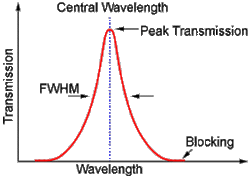|
Interference filters combine many thin-film layers of dielectric materials having differing refractive indices to produce constructive and destructive interference in the transmitted light. In this way filters can be designed to transmit in a specific waveband only, and can function as edge filters or bandpass filters.
|
|
|
Interference filters are often designed to pass only a specific wavelength range. The range limitations are usually dependant upon the interference filters lens, and the composition of the thin-film filter material. Interference filters designed to transmit near infrared wavelengths are tuned to the 750nm to 2500nm wavelength range; visible, for use in the 380nm to 750nm wavelength range; and ultra-violet, for use in the 4nm to 380nm wavelength range.
|
|
|
In interference filters, wavelength selection is based on the property of destructive light interference, which is the same principle underlying the operation of a Fabry-Perot interferometer. Incident light is passed through two coated reflecting surfaces. The distance between the reflective coatings determines which wavelengths will destructively interfere and which wavelengths will be allowed to pass through the coated surfaces. In situations where the reflected beams are in phase, the light will pass through the two reflective surfaces. However, if the wavelengths are out of phase, destructive interference will block most of the reflections, allowing almost nothing to transmit through. In this way, interference filters are able to attenuate the intensity of transmitted light at wavelengths that are higher or lower than desired.
|
 |
|
The gap between the two reflecting surfaces houses the spacer, a thin film of dielectric material. The spacer has a thickness of one-half of the desired peak transmission wavelength, as opposed to the two outer, reflective layers, which are usually a quarter wave thick. This entire layer is often referred to as the stack, which in conjunction with the spacer form a bandpass filter. The width of the bandpass can be adjusted based upon the number of stacks present within the interference filter. These multi-bandpass designs often present a flat transition for out-of-passband wavelengths. Introducing several cavities into the interference filter, in turn, may sharpen these wavelengths. If this is the case, additional layers of thin-film coatings may need to be added to block the transmission of waves that will be generated outside of the desired range.
|
|